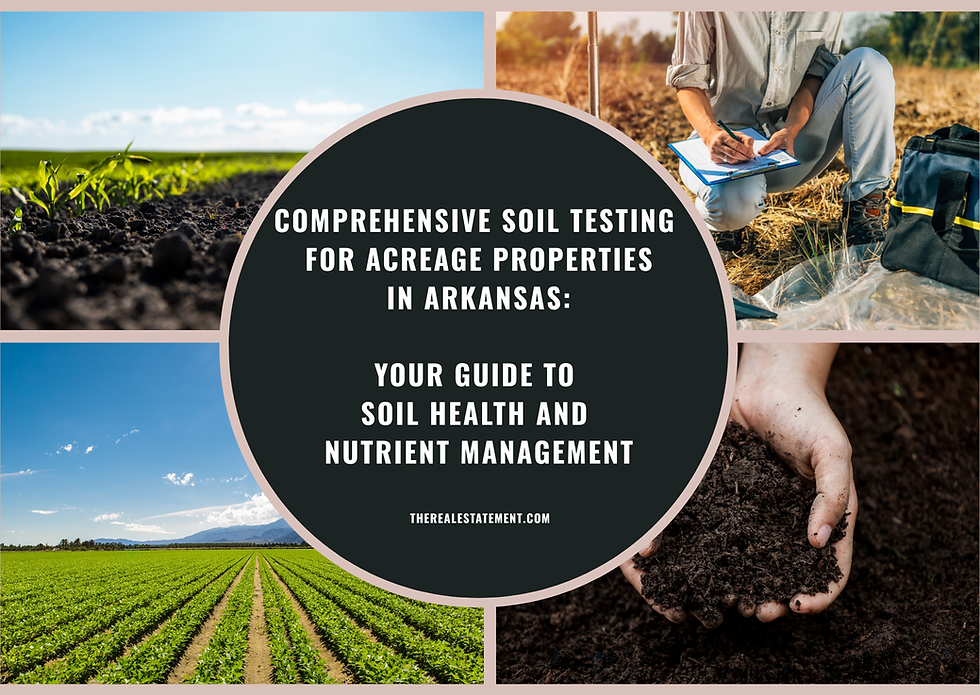
Comprehensive Soil Testing for Acreage Properties in Arkansas: Your Guide to Soil Health and Nutrient Management
- Christy Robinson

- Oct 20
- 4 min read

Arkansas acreage stretches from Delta silty bottoms to Ozark hills, and no two soils behave the same. A simple, consistent soil test is the #1 way to dial in fertility, cut waste, and protect our waterways. This guide covers Arkansas soil types, how to sample correctly, what the lab numbers mean, cost/benefit math, and how to turn results into a practical fertilizer + soil-health plan—whether you use a commercial soil testing service or submit to the Marianna Soil Test Laboratory.
Arkansas Soil Types (and what they mean for management)
Soil Type | Texture | Why it matters |
Stuttgart silt loam | Silt loam | Naturally fertile with strong water-holding; great for row crops and gardens. |
Eutaw clay | Silty clay | Holds water/nutrients but drains slowly; watch compaction and timing. |
Captina silt loam | Silt loam | Good structure and moderate OM; flexible land use. |
Linker fine sandy loam | Sandy loam | Drains fast; needs organic matter and split nutrient applications. |
Heiden clay | Clay | Heavy; benefits from traffic control, residue cover, and structure-building practices. |
Texture sets water and air movement; organic matter (OM) drives nutrient cycling and resilience. Your test helps tailor lime, fertilizer, and OM targets to each field or pasture.
What a Soil Test Measures (Arkansas panels)
pH + buffer pH → lime or sulfur need
Macronutrients → P, K (often Ca, Mg), N guidance by crop
Secondary/micronutrients (optional) → S, Zn, Fe, Mn, Cu, B
OM % (loss-on-ignition) → fertility resilience and C sequestration indicator
Texture/EC (optional) → infiltration, salinity clues
Target pH: most crops and forages do best at 6.0–7.0. Blueberries/azaleas prefer lower; alfalfa prefers higher.
How to Sample Acreage Correctly (the step that makes or breaks accuracy)
Before you start
Split your property into management zones (by soil type, slope, crop history, problem spots).
Avoid odd patches (burn piles, gates, tractor ruts) when compositing.
Field & pasture depth
0–6 inches (15 cm). Pull 15–20 cores per zone using a clean probe; zigzag pattern.
Mix cores in a clean bucket; air-dry (don’t oven-bake); bag and label (farm, field/zone, depth, date, intended crop).
Lawns & gardens on acreage
Lawns: 0–4 inches; Gardens: 0–6 inches; 10–15 cores composite.
How often
Row crops/pasture: every 3–5 years (or annually when manure programs or major changes).
Lawns/gardens/orchards: every 1–2 years.
Tools checklistProbe/auger • paper bags or lab kits • marker • GPS/phone for coordinates • sample log.
Where to Send Samples (Arkansas options)
Marianna Soil Test Laboratory (University of Arkansas System Division of Agriculture):Routine tests are free for Arkansas residents (funded by fertilizer tonnage fees).Advanced testing (micros/OM/texture/contaminants) is fee-based.
County Extension Offices: drop-off points, protocols, and help interpreting reports.
Commercial labs/consultants: useful for rush jobs, precision ag grids, specialty crops, or comprehensive micronutrient packages.
Turnaround: typically 7–10 days for routine panels.
Costs & ROI (in plain numbers)
Routine Arkansas panel: $0 (for residents via Marianna; limit policies may apply per submission).
Advanced/commercial panels: typically $20–$40 per composite sample depending on add-ons (micros, OM, texture).
Why it pays: Right-sized fertilizer and lime routinely save $10–$40/ac and can boost yields 10–20% in pastures/row crops—often paying for testing in one season.
Reading Your Soil Test (and what to do next)
Check pH & buffer pH
If pH < 6.0, apply ag lime per report (split if >2 tons/ac). Re-test in 12 months after a large correction.
Match P & K to crop removal
Apply per recommendation; in sandy soils, split K to limit leaching.
Micros (when to care)
Zinc for corn/rice; Boron for alfalfa/brassicas; Iron/Manganese issues on high pH soils; follow lab ranges.
Nitrogen
Based on crop and yield goal; consider pre-plant + sidedress or split applications to track rainfall risk.
Organic Matter %
<2%: add cover crops/compost/manure, reduce bare soil time.
3–5%: maintain residue, minimize tillage passes.
Build a Sustainable Nutrient & Soil-Health Plan
Lime right: pH in range unlocks your fertilizer dollars.
Cover crops: rye/crimson clover/radish mixes add OM, scavenge N, reduce erosion.
Manure/compost: apply to soil test need; incorporate or inject to reduce loss.
Split apps & banding: especially on sands and where P fixation is high.
Traffic control: reduce compaction; consider controlled wheel tracks.
Drainage fixes: surface ditches, grassed waterways; tile where appropriate.
Gypsum (not lime): helps with sodic soils or structure in some clays (does not change pH).
Quick Arkansas Cheat Sheet (by soil behavior)
Delta silt loams: strong response to balanced P & K; maintain residue to prevent crusting.
Clay uplands (Gulf Coastal Plain): time field work to avoid smearing; watch for K fixation and compaction.
Ozark rocky loams: shallow rooting—prioritize OM, perennials, and contour practices; great for silvopasture.
Sandy ridges: spoon-feed N & K; mulch/cover to fight leaching and heat stress.
Environmental Stewardship & Compliance (the win-win)
Right-rate, right-time, right-place nutrients reduce runoff and leaching.
Maintain 50–100 ft vegetative buffers near streams.
Keep records of rates, products, dates, and weather—good for audits and management.
Frequently Asked (Arkansas-specific)
What’s included in a “routine” test here?
pH, buffer pH, P, K, Ca, Mg (often S), and OM—with fertilizer & lime recs for your intended crop.
Best time to sample?
Any consistent time annually; many sample post-harvest or late winter before pre-plant.
Do I need GPS points?
Not required, but logging coordinates lets you re-sample the same zones and track improvements.
How deep for orchards and hay fields?
Standard 0–6" for fertility; consider 0–6" and 6–12" profiles when diagnosing deeper pH or salinity issues.
How soon after liming/fertilizing can I re-test?
Wait 3–6 months after lime and 6–8 weeks after fertilizer to avoid skewed readings.
%20Black%20(Address).png)







Comments